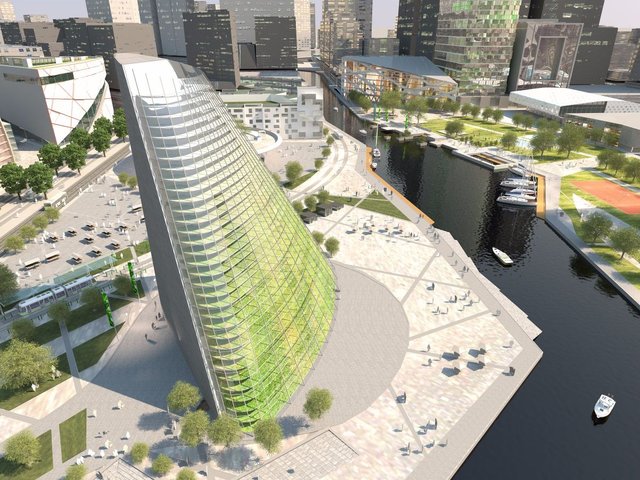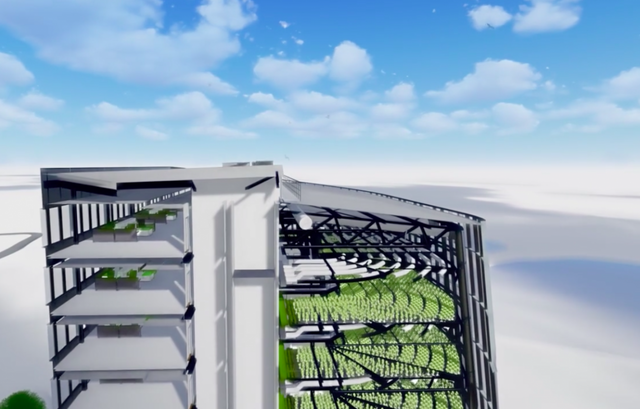A Future Filled With Foodscrapers

A Swedish company known as Plantagon is putting vertical farming technology to use by crafting their plans for foodscrapers of the future.
They can help offices to make the best use of their empty space and enable them to start using that space to grow food. Plantagon is working to move food production into big cities by implementing technical solutions into existing buildings.
Vertical farming technology would allow those behind the project to craft vertical greenhouses, which have also been referred to as plantscrapers.

They are already working on such a building, which will be located in Sweden, and it's estimated to be costing around $40 million to put together. When they are done, and the farm is operational, it'll be able to feed around 5,000 people per year. The hope is that the building will officially open in 2020.
Following the open of their building in Sweden, known as the World Food Building, they also have plans to undertake such projects in the US, Hong Kong, Singapore, and Shanghai.

There are a variety of hydroponic and vertical farming projects that are already underway around the world, in Shanghai, the US, and elsewhere.
Vertical farming technology is a growing trend right now in the farming industry and we can expect that in the years to come many farmers from different countries will be turning to experiment with this technology; making changes to incorporate vertical farming into their growing methods.
The vertical farming market is expected to grow at least 20 percent per year and by 2022 it's estimated that it will reach almost $6 billion ($5.80 billion). Last year, this market was valued to be around $1.5 billion and by 2025 is suggested that it will pass $9 billion.
Pics:
Plantagon via futurism
Plantagon via futurism
pixabay
Sources:
http://www.plantagon.com/
https://futurism.com/move-over-skyscrapers-plantscraper-5000-year/
http://www.digitaljournal.com/tech-and-science/technology/plantagon-feeding-the-world-with-vertical-farming-technology/article/508590
https://www.marketsandmarkets.com/Market-Reports/vertical-farming-market-221795343.html
http://www.businesswire.com/news/home/20170810005548/en/Vertical-Farming-Market-Reach-6.4-Billion-2023
http://www.grandviewresearch.com/press-release/global-vertical-farming-market
Related Posts:
Construction On Shanghai's Hydroponic Vertical Farm Expected To Start This Year
Hydroponics Market Expected To Show Tremendous Growth In Years To Come
Indoor Vertical Farm Capable Of Feeding More Than 180,000
https://steemit.com/food/@doitvoluntarily/indoor-vertical-farm-capable-of-feeding-more-than-180-000
What a great article, it gives hope in humanity! Well done!!!
Considering the investments and the size, the expectations of it being able to feed around 5,000 people per year is a very very low estimate. If the soil is any good, judging by the size of the building, it should feed an awful lot more than 5000 people a year. A sustainable permaculture garden using less than 2 acres can feed 50 families, how much surface to they have within this structure?
Thanks again for such quality content, it is a pleasure to upvote 100% and resteem its content too.
Namaste :)
Very cool news @doitvoluntarily! :) Haven't heard about the project before and I live in Sweden! Will definitely keep my eyes on it! :)
in Linköping 👍😄
This is great. Something has to change. We need more innovation in our agricultural systems or starvation will become a greater and greater first world problem.
"70% of our fresh water contamination comes from agriculture, and about 70% of our fresh water usage goes to agriculture, and 1/3 of our arable land has been degraded in the last 40 years"
Also check this out, Vertical farming in your apartment today:
https://littlegreendot.com/urban-farming-in-your-own-apartment/
It is a first world problem in the first place as it is caused by that way of living. It has never been seen on such an extended period of time, outside of such civilization before, only within it. Though natural processes do bring about starvation through its processes, this one is caused and sustained by humans.
Vertical farming is an efficient way of doing agriculture, but what are we to do as humans towards other humans and other animals, plants and full ecosystems in general?
Namaste :)
Agreed. My point was that this problem need innovative solutions and aggricultural revolution can be part of that innovation.
How about nothing? Sometimes the best thing to do is not to do anything at all.
Back in the 1980s I drew up a nonprofit that was intended to lease land from those with extensive holdings, for the purpose of leaving it fallow.
It was more ambitious than my fundraising skillset, and eventually became $1000 investment in worthless bylaws, articles of incorporation, etc.
'Don't just do something. Sit there!' -- Valued Customer.
I love your last quote, this is something I often tell people!?. I take that you live in Alaska, maybe my thoughts were heard from Haida Gwaii!?! LOL!!!
Namaste :)
I was raised in Alaska, and my youth has informed my dotage with the lessons learned there.
Working construction, I have all too often heard the inverse 'Do something, even if it's wrong.' After having to undo, and redo, a few things, I'd much rather take a minute to make sure something is worth doing before undertaking it.
Powerful words of wisdom that come with the experiential knowledge behind it. Can't beat that with a stick right?!. Awesome!!!
Namaste :)
Agree with that. We have technology and knowledge to feed 10 billion people. Vertical farming have a future with hydroponics /aquaponics /aeroponics, but not in foodscrapers. Foodscrapers are not practical.
They are practical in building a centralized area where human can use less energy and less land surface, especially since the lands of our small planet are being decimated by our careless encroachment, destroying our own ecosystem.
Using a building constructed with sustainable material would allow us to use the technologies available through the uprise of efficient hydroponics, aquaponics and aeroponics systems within the building construction, therefore building as sustainable a construction as is in the engineering of its social, environmental and energy impact on the planet and all of its inhabitants. Meanwhile, the natural ecosystems around us would have some time to recover from our on-slaught over the passed centuries thus re-establishing and solidifying the natural cycles from which life emerged and thrived.
Namaste :)
The vertical farm from the clip looked like 1 floor storage space.
There is a reason for the high rents of office space in skyscrapers. It is hard to build very high buildings, and it is expensive to maintain them. When we build more than 10 storey building there are only two materials - steel and reinforced concrete (not environmental friendly). There will be also high electricity consumption for water. We need pumps to push the water to reservoir on 15 floor then other pumps to deliver the water from 15 to 30 floor, etc. I am sure there also will be problems with air conditioning. I think it is just not sustainable to use high building for a farm. Low buildings with glass roofs or artificial lights will be better. Humans occupy less than 5% of the land mass of the planet we have space for hydroponics.
Cheers
Furthermore...
For the moment, most of the material used to make high rise is in deed underlined in your note just above, but loads of new materials are arising and finding their way into structures of all sizes and 3-D designed printed. According to the researches made on the use of skyscrapers of all sort, we could use such building strictly for agricultural necessities and water could be either brought up and/or gathered as well. Many options of energy alternatives are offered and already running on the front. the buildings themselves wouldn't need to be containing any offices. the use of wind gathered within the buildings' structures allows for electricity generation and thus providing for all energy consumptions necessary for water/air pumping, when needed and where moisture, water and heat is needed as per arcology principles, see Arcosanti publications.
Great conversation, by the way, thanks a lot for this as it is such an important topic we need to tackle as a civilization.
Namaste :)
Yes great conversation. It is true we impacting the whole planet. By 5% I mean concentrated urban population. There is a lot of space around the cities not occupied by wild life. We can use hydroponics and vertical farms in the suburban area. Skyscrapers for food is just not the way in my opinion. Nations build skyscrapers mostly for prestige not because they need them so badly... There are new materials. Nanotubes are promising but we can’t manufacture them in big industrial scale. No buildings from nanotubes any time soon...
Cheers :)
It is exciting. My feral youth on an Alaskan island has caused me to eschew cities and urbanization, due to the paucity of vibrant life in such places.
Incorporating ecosystems into our urban infrastructure, much as our very bodies are becoming understood to be ecosystemic infrastructure (about 10% of the cells in your body are YOUR cells, the rest are essential ecosystem without which humans cannot survive), is essential to creating environments in which humans thrive.
Our need for nature, for the complexity of forms, niches, and synchronicity, which we need to interface with (in my case, daily) to be happy, is more and more evident in studies in diverse fields, from sociology, to biology, to civil engineering.
Starvation is not about agricultural systems. Developed countries throw away 30%-40% of their food.
I have never seen or heard of projects like that before so thank you for sharing this I guess future with us.
This is what the future looks like... some say the closing shopping malls would make perfect indoor farms.
Vertical Farming definitely has potential to do great things. However, the food industry needs to be included in this implementation process because this technology will completely change the way we buy and produce food in the economically developed part of the world.
We are curious to know what the food industry is doing with this technology? Because if they do not cooperate this will never take off.
Cargill, Monsanto, et al., are, hopefully, so busy laughing all the way to the bank from their present predatory successes that they will ignore this endeavor, at least until some entrepreneurial success has attracted talent that might pose an impediment to transnational oligarchical predation.
Yes it seems so that vertical farming is left alone, but it is fair to assume that Supermarket chains will want to take action since it will disrupt the entire way cities acquire food right?
Supermarkets shouldn't generally be impacted by changing where foods are grown, as they aren't involved in that process. The foods are delivered to the markets, from where ever they are grown, and markets sell them.
They don't care, and aren't impacted, except as the producers change, and prices change.
Amazing I have been waiting for the vertical farming to take off amazing!
thanks for stopping by @vibeof100monkeys ! :)
Cool post, but I am not so optimistic about the foodscrapers.
Alterra did something similar on parking structure in Vancouver where fresh greens are scarce in the winter. They used a hydroponic system and got lots of funding (debt). They declared bankruptcy 25 million in debt. The major concerns were the cost of infastructure compared to profits from growing fresh greens (3-4 weeks seed to harvest). Growing fruit crops like eggplant would have been economically challenging.
Outside of the wow-factors (urban, organic, local), there was the harsh reality of high overhead costs and slim profit margins.
Tread carefully!
The vertical farm is really cool. It does have the Agenda 2030 smell to it, however. And, as with most tech, it will be found to miss something essential to human health-- contact of our food with the earth. Upvoted and Resteemed! @dakini5d